Text
Azerothian Botany - Spideroot
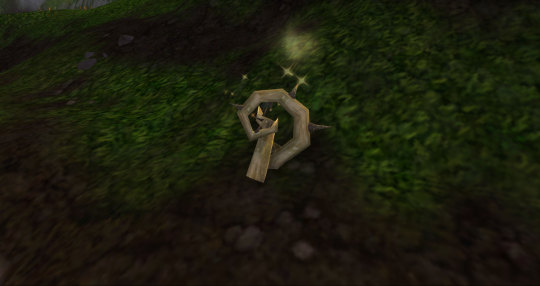
Spideroot contains a sour-tasting liquid known for its natural weedkilling properties [Item: Spideroot]. Because it happens to be good for most plants except for weeds, some Pandaren farmers in the Heartland have taken to using spideroot to remove any unwanted plants from their crops [Quest: Growing the Farm I: A Little Problem].
Spider mites are commonly found on spideroot, which may be how the plant came by its name [Quest: Growing the Farm I: A Little Problem].
23 notes
·
View notes
Text
Cultural Beliefs About the Afterlife - Tuskarr

Compared to several of Azeroth’s native races, the tuskarr have some of the most intricate beliefs about death and the afterlife. Many of those beliefs are so important to the tuskarr that they play a significant role in kalu’ak cultural practices and their day-to-day lives, from how they worship their ancestors to the various rituals they perform in honor of the dead.
According to the non-canon RPG, the tuskarr see the afterlife as a trouble-free paradise in which both fishing and whaling – two activities integral to their way of life – are plentiful [RPG: Dark Factions, pg. 22, 88, RPG: Manual of Monsters, pg. 105]. Their cultural beliefs dictate that those who want to make it to the afterlife should engage in certain social behaviors the tuskarr view as positive. Examples include marriage, bearing children, and hunting, among other things [RPG: Dark Factions, pg. 88].
Once a tuskarr dies, it is believed that Karkut, their death deity, walks the earth to gather their spirit and take them to the afterlife [Quest: Preparing For the Worst]. Karkut is also responsible for protecting and watching over the spirits of the fallen [Quest: Cowards and Fools, Quest: The Son of Karkut, Quest: Spirits Watch Over Us]. Interestingly, Death Knights are said to bear his mark [Quest: The Son of Karkut].
Not unlike the tauren, tuskarr ancestor spirits are a significant part of their culture – so much so that some of their more notable ancestors are ceremonially placed in large stone statues specially prepared by tuskarr craftsmen [Quest: Leading the Ancestors Home, Quest: Picking up the Pieces]. This sacred ritual is carried out by a shaman, who uses implements – some of which are hundreds of years old – to guide the spirits into their new homes [Quest: Leading the Ancestors Home, Quest: Picking Up the Pieces]. From there, the ancestors of the tuskarr can watch over and protect their living kin. Some even go so far as to heal the sick and offer advice to those who ask for their guidance [RPG: Manual of Monsters, pg. 105, Quest: The Honored Ancestors].
Tuskarr legends are rife with mention of “coffer corpses,” better known as independent undead with no connections to the Scourge. Though they may show up frequently in tuskarr tales, modern kalu’ak death practices have somehow made the occurrence of real coffer corpses rare, although it is unclear why [RPG: Manual of Monsters, pg. 199].
The tuskarr have different death rituals to honor those who meet their end at sea or fall in battle [RPG: Dark Factions, pg. 22].
21 notes
·
View notes
Text
The Folk & Fairy Tales of Azeroth Lore Facts

Editor’s Note: “Some of the tales you’ll encounter here may be rooted in canon, or they may be another traveler just telling a tall tale.”
Eyes of the Earth Mother
Though the Earth Mother heard the whispers of the Old Gods, she could not be swayed by them (13).
Pregnant, the Earth Mother sought a place away from the Old Gods’ corruptive influence to give birth to her children. Unable to find such a place, however, she decided to shape the world and, in doing so, create her own safe haven (14).
All of Azeroth’s lands, waters, and even the elements themselves came forth at this moment. They were suffused with enough of the Earth Mother’s essence so soon after their inception that they kept the Old Gods’ powers at bay (14).
The Earth Mother gave birth to twins: first An’she, a beacon of life and warmth, then came Mu’sha, who was to bring rest, tranquility, and healing. The elements called them the “sun” and the “moon” (15).
Eventually, both An’she and Mu’sha developed connections with the elements. An’she found himself able to wield the light and warmth of fire while Mu’sha maintained some control over the tides and winds (15-16).
The twins even went so far as to use the elements to create weapons to spar with. Mu’sha opted for a bow and arrow, whereas An’she’s weapon of choice was a set of blades (16).
To keep her children safe from the Old Gods’ ever-present influence while she slept, the Earth Mother took both An’she and Mu’sha up into her eyes. Their power was so great that she had to keep one eye open at all times (16).
This, however, meant that Azeroth no longer received An’she’s warmth or Mu’sha’s guidance of the wind while the Earth Mother rested. Cold slowly spread across the land and blizzards raged until she finally woke again (18).
The Earth Mother’s cycle between periods of sleep and awakening would come to form the basis of the seasons as we know them, with her time of work the summer and her time of rest the winter (18).
As the twins grew in power, they developed the ability to bring on the change of seasons at will, though they took care to do it slowly and give the world time to adjust. As the Earth Mother rested, An’she and Mu’sha continued to tend to Azeroth from behind her eyes (19).
After waking at one point, the Earth Mother found that there was new life walking the earth. Plucking wheat from the plains to sprinkle over them, the Earth Mother called them “Shu’halo,” - the tauren (19).
Just as the Earth Mother taught her children, both An’she and Mu’sha taught the Shu’halo in the ways of the elements and caring for the land (20).
When the Earth Mother next slept, however, the Old Gods extended their influence to the tauren, causing them to grow violent and turn on their own kind (20).
Saddened to see the tauren fall to such corruption, the Earth Mother shed a single tear. She realized that the land was no longer able to hold the Old Gods’ power at bay, meaning anything it touched could be corrupted (21).
Knowing that she was not safe for her children anymore because of her own connection to the land, the Earth Mother removed An’she and Mu’sha from her eyes and laid down in despair (21-22).
The single tear that the Earth Mother had shed became a blue baby, later named “Lo’sho,” or the Blue Child (22, 24).
Seeking to put an end to the Old Gods after what they had done to the tauren and the despair they instilled in their mother, An’she and Mu’sha fought against some of the eldritch beings’ manifestations. During the battle, An’she was wounded grievously. Though Mu’sha sought to heal him with wind and water, he continued to bleed (24).
The Earth Mother, stirred by her distant children’s dismay, eventually found her way to them. She urged them to take Lo’sho and go to the heavens so they could protect Azeroth from above, while the Earth Mother chose to root herself in the earth and prevent the Old Gods from ever claiming her children (26-27).
Mu’sha, the moon, continues to follow An’she closely across the sky so she can keep tending to his wounds (26).
Weiterlesen
182 notes
·
View notes
Text
Azerothian Botany - Sanguine Hibiscus

The Underbog is home to a plethora of unique plant species that do not grow naturally anywhere else on Outland [NPC: T’shu Dialogue, Quest: Bring Me A Shrubbery!]. The most popular – and perhaps most common – of these is a bright red flower known as sanguine hibiscus [Quest: Bring Me A Shrubbery!].
Sporelings native to Zangarmarsh reportedly use sanguine hibiscus for a number of purposes, though what those uses could be that they value adventurers who provide them with large quantities of the plant so highly is unclear [Quest: Bring Me A Shrubbery!].
35 notes
·
View notes
Text
Azerothian Botany - Midnight Rose
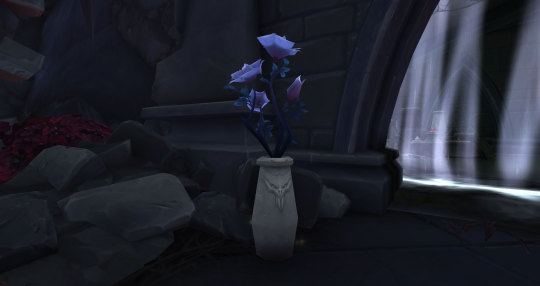
The Venthyr’s love of gaudy ornamentation makes it no surprise that they cultivate a variety of beautiful flowers. Of these, one of the most popular seems to be the midnight rose, a lilac-colored bloom commonly seen all over Revendreth [NPC: Lord Silviu Dialogue]. This flower is more than just pretty decoration, however; midnight roses enable the Venthyr to move through the shadows quicker than normal [Buff: Midnight Rose]. That said, exactly how such an effect is achieved – whether via smell, ingestion, or some other means – is unclear.
38 notes
·
View notes
Text
Azerothian Botany - Rotberry
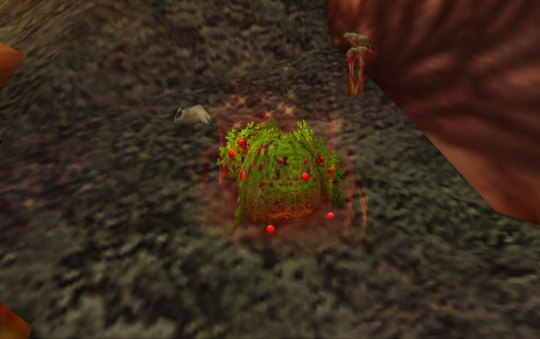
Though the Plaguelands’ native flora has started to regrow in thanks to the combined efforts of the Cenarion Circle and the Argent Crusade, much of the region’s wildlife still suffers from the plague’s influence today [Quest: Zen’kiki, the Druid, Quest: Postponing the Inevitable]. The Plaguewood, located just outside Stratholme, is home to all sorts of blighted vegetation, including a bright red fruit inauspiciously known as the rotberry. While many species of wild berries found on Azeroth are edible, it is probably safe to assume that rotberries are not fit for human consumption [Item: Rotberry].
A Forsaken apothecary once experimented with rotberries – among several other reagents – in search of a counter-plague agent, though it is unclear if he ever succeeded [Quest: Counter-Plague Research].
35 notes
·
View notes
Text
The Formation & Ideologies of the Holy Orders of the Light
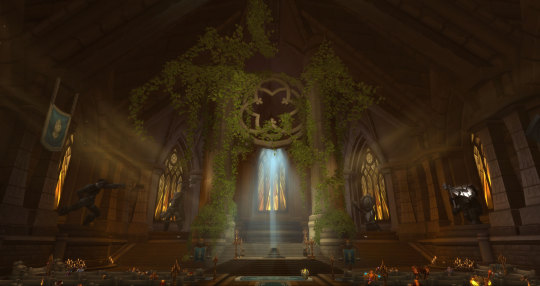
The Church of the Holy Light
Humanity’s foremost religious organization, the Church of the Holy Light, was formally established in the heart of Lordaeron many centuries ago. The spiritual teachings that gave birth to the church, however, date back much further to the time of the Troll Wars when a human warrior named Mereldar began having visions of beings made of the Light. Those strange holy lifeforms – known as naaru – taught her and others about the wisdom of virtues such as protection, justice, retribution, holiness, and compassion – all tenets that would later be embodied and espoused by countless paladins and priests of the church. Enlightened, Mereldar and the others set out to write down the beings’ teachings in a series of books that quickly sparked the formation of a significant religious movement in the Eastern Kingdoms [World of Warcraft Chronicle Volume II, pg. 126]. The Church of the Holy Light, as it would come to be known, eventually expounded all sorts of other virtuous ideals, but its core principles – the five tenets put forth by Mereldar – would always remain unchanged.
Weiterlesen
63 notes
·
View notes
Text
A Brief History of the Church of the Holy Light and Its Sects
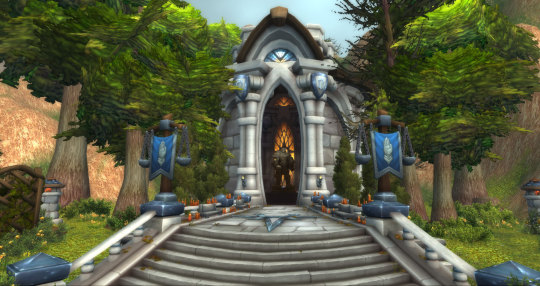
Approx. 2800 Years Before the Dark Portal Opens
A human warrior named Mereldar begins having visions of beings made of the Light. They teach her and a select few others about the wisdom of virtues such as protection, justice, retribution, holiness, and compassion. Enlightened, Mereldar and the others set out to write down the beings’ teachings in a series of books that eventually inspire the formation of the Church of the Holy Light [World of Warcraft Chronicle Volume II, pg. 126].
?? Years Before the Dark Portal Opens
The Church of the Holy Light is formally established in Lordaeron [World of Warcraft Chronicle Volume II, pg. 126].
?? Years Before the Dark Portal Opens
Some members of the Church move south and found the Holy Order of Northshire Clerics on the outskirts of Stormwind City [World of Warcraft Chronicle Volume II, pg. 125].
The Dark Portal Opens
The orcs invade Azeroth, beginning the First War.
1 Year After the Dark Portal Opens
The Northshire Clerics – unarmed, untrained, and unable to defend themselves – are killed when the orcish horde razes Stormwind City, though some survive and flee to Southshore with other refugees [World of Warcraft Chronicle Volume II, pg. 125-126].
4 Years After the Dark Portal Opens
The Second War begins.
5 Years After the Dark Portal Opens
Distraught at what had happened to the Northshire clerics during the First War, Archbishop Alonsus Faol proposes the idea of training a small group of priests and knights to wield the Light in battle. They become known as the Order of the Knights of the Silver Hand [Tides of Darkness, Chapter Five].
7 Years After the Dark Portal Opens
The Second War ends.
Archbishop Faol re-establishes the mostly defunct Holy Order of Northshire Clerics under the new name the Brotherhood of Northshire [Plaque: Archbishop Alonsus Faol].
20 Years After the Dark Portal Opens
Prince Arthas attempts to suspend the Knights of the Silver Hand from service after Uther refuses to join him in culling the infected civilians of Stratholme. Though this does not hold, a rift begins opening up between the members of the order over who should and should not be allowed to join their vaunted ranks [NPC: Arthas Dialogue, Ashbringer: Death is Contagious, Ashes to Ashes].
21 Years After the Dark Portal Opens
Alexandros Mograine, the Ashbringer, dies at the hand of one of his sons during battle [Ashbringer: Ashes to Ashes].
21 Years After the Dark Portal Opens
Maxwell Tyrosus, disgusted at his comrades’ refusal to allow any non-humans in the Knights of the Silver Hand, leaves and forms his own organization that would not only continue to preach the values of the Holy Light, but also accept all races. This new religious group is called the Argent Dawn [World of Warcraft Chronicle Volume III, pg. 103, Ashbringer: Ashes to Ashes].
21 Years After the Dark Portal Opens
The remaining members of the Knights of the Silver Hand officially rebrand themselves the Scarlet Crusade and take up residence in the Scarlet Monastery [Ashbringer: Ashes to Ashes].
Approx. 23 – 24 Years After the Dark Portal Opens
A select few who shirk the Argent Dawn’s strict code of morals break off from the order and form the Brotherhood of the Light [NPC: Crusade Commander Korfax Dialogue].
25 Years After the Dark Portal Opens
The Knights of the Silver Hand are reformed by Tirion Fordring [Quest: In Dreams].
26-27 Years After the Dark Portal Opens
After the events at Light’s Hope Chapel that culminates in many death knights gaining independence from the Lich King, Tirion Fordring takes it upon himself to merge the Argent Dawn and the second iteration of the Knights of the Silver Hand into a new organization known as the Argent Crusade [Quest: The Light of Dawn].
27 Years After the Dark Portal Opens
The idea of a “Scarlet revival” made from an elite cadre of the Crusade’s most faithful emerges. It is not until the Scarlet Crusaders leave the Eastern Plaguelands arrive in Dragonblight that their leader, High General Brigitte Abbendis, officially sanctions the Scarlet Onslaught [Item: The Diary of High General Abbendis, NPC: Lord-Commander Arete Dialogue].
32 Years After the Dark Portal Opens
The Knights of the Silver Hand are revived for a third and final time following Tirion Fordring’s death at the Broken Shore [Quest: A United Force].
95 notes
·
View notes
Text
Azerothian Botany - Dreadshade (Shadowlands)

Dreadshade is a species of lasher known for producing an extract that has highly versatile, albeit potentially deadly, properties [Item: Dreadshade Extract]. Maldraxxi alchemists of the House of Plagues cultivate the plant to use as a reagent in some of their concoctions, many of which are no doubt extremely toxic. That said, dreadshade has other known practical applications. For example, one of the house’s foremost plague devisers planned to use dreadshade extract in a potion that would effectively “preserve” the imbiber [Quest: Plague is Thicker Than Water, Quest: By Any Other Name].
Dreadshade is said to be the carrier of Solanum cerinthe [Quest: By Any Other Name]. What this is, however, is unclear, though the name suggests it is the scientific name for a plant or fruit.
18 notes
·
View notes
Photo


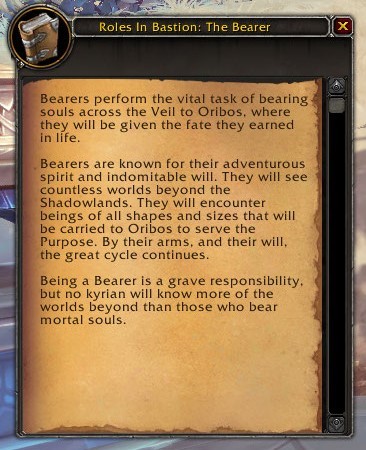


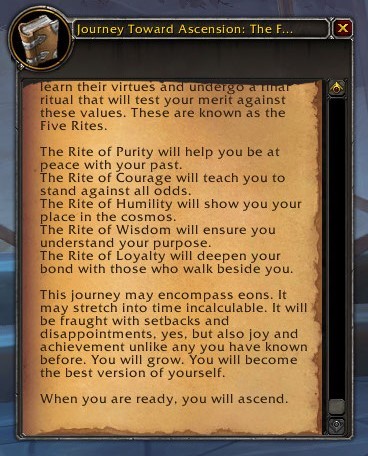
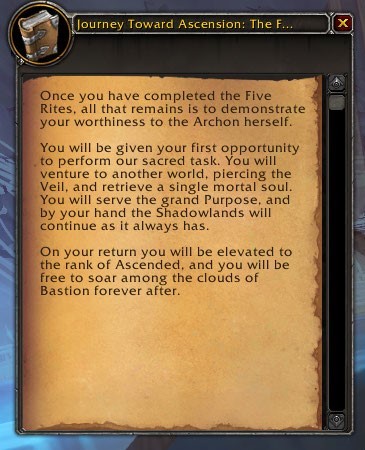
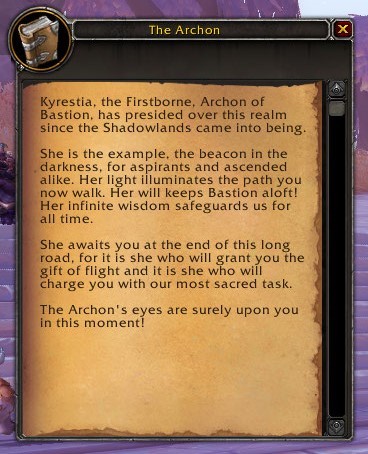


Some Bastion lore placards in the starting area that may answer any questions you have regarding: who exactly are the Kyrian? What are the rites they go through? And what role do they play in the Shadowlands?
180 notes
·
View notes
Text
Azerothian Botany - Olemba Tree
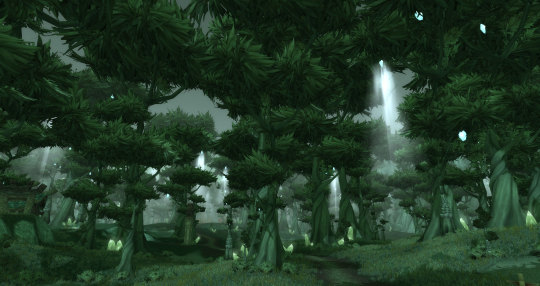
One of the most common plant species found on Outland today is the olemba tree, a conifer that dominates much of Terokkar Forest’s ecosystem [Item: Greatmother’s List of Herbs].
The olemba tree stores its seeds in tough, fist-sized cones that, once they reach maturity, fall from the branches of the tree [Quest: Olemba Seeds, Item: Olemba Seed]. The seeds themselves are exceptionally oily and can be pressed into a high-quality mana oil [Quest: And Now, the Moment of Truth].

Hapless adventurers were once tricked by Greatmother Geyah into believing that olemba tree roots were a key ingredient in an elixir that would allow them to see and commune with the spirits of the dead [Quest: Material Components]. As it turns out, however, the potion was merely a test of the adventurers’ dedication and actually had no real effects whatsoever [Quest: To Meet Mother Kashur].
33 notes
·
View notes
Text
Lore Fact of the Week #74

According to the non-canon RPG, the Jaserplode and Fargodeep gold mines in Elwynn Forest were seized by the orcs during the First War to fuel their war efforts [RPG: Lands of Conflict, pg. 49]. When the humans finally routed the orcs out of their lands after the end of the Second War nearly four years later, they successfully recaptured the mines, only to lose them again to the forces of the Defias Brotherhood some time following the Third War [RPG: Lands of Conflict, pg. 49, World of Warcraft Chronicle Volume II, pg. 175, 177, Item: Wiley’s Note, Quest: The Fargodeep Mine, Quest: The Jasperlode Mine]. Kobolds, working at the behest of the disgraced stonemasons, invaded the mines, although exactly what they were doing for the Defias is unclear [Item: Wiley’s Note].
21 notes
·
View notes
Text
Azerothian Botany - Burstcap Mushroom
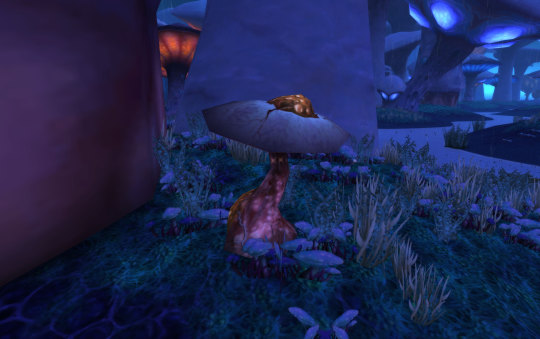
Widely considered one of the most dangerous regions in all of Outland, Zangarmarsh is home to a diverse range of plant life. Though beautiful, much of the fungal swamp’s flora is quite deadly [Illidan, Chapter Three]. One particularly virulent type of fungi native to Zangarmarsh is the burstcap mushroom, which predominantly grows in the western part of the region. True to its name, the burstcap is extremely sensitive and can release a toxic cloud of spores if handled improperly [Quest: Burstcap Mushrooms, Mon!, Item: Burstcap Mushroom].
28 notes
·
View notes
Text
Lore Fact of the Week #73

Banshees have access to the powers of those whose bodies they possess so long as they are inhabiting them [Quest: Reading the Bones, Page: Baroness Anastari].
23 notes
·
View notes
Text
Azerothian Botany - Flower of Luck

Some plant species only bloom during the Lunar Festival, a two-week-long celebration commemorating the Burning Legion’s defeat during the War of the Ancients 10,000 years ago [Page: Lunar Festival, Quest: Elune’s Blessing, Quest: Crown of Good Fortune]. According to popular belief, each of the short-lived flowers has a special connection to the moon goddess, Elune [Quest: Crown of Dark Blossoms]. One of them, the flower of luck, is even thought to be a favorite of hers [Quest: Crown of Good Fortune].
Though it only blooms for a brief time, the flower of luck normally grows in southern Dun Morogh [Quest: Crown of Good Fortune].
Lunar Festival celebrants traditionally weave the flower of luck and other blossoms into flower crowns to wear during the holiday [Quest: Crown of Good Fortune, Item: Crown of Everlasting Fortune].
59 notes
·
View notes
Text
Lore Fact of the Week #71

Although it stood as virtually the last great human city of the original Alliance after the Third War, Stormwind City still relied heavily upon other kingdoms for several of its main imports [Book: The Alliance Splinters, World of Warcraft Chronicle Volume III, pg. 112, Cinematic: The Destruction of Dalaran]. In fact, when both Dalaran and Quel’Thalas fell during the Third War, merchants found it incredibly difficult to come by certain magical wares, especially enchanting supplies [Classic NPC: Jessara Cordell Dialogue]. What Stormwind’s craftsmen lacked in those, however, they made up for in other areas. The elves supplied the humans with an abundance of alchemical goods specially crafted in Teldrassil and brought over as a gesture of good will between the two races [Classic NPC: Eldraeith Dialogue].
39 notes
·
View notes
Text
Lore Fact of the Week #70

Few artifacts are as well-known as the Demon Soul, a relic so powerful that it could not only vaporize entire armies in an instant, but also control and enslave any dragon, including the aspects themselves [The Demon Soul, Chapter Twenty]. What some may not know, however, is that the Demon Soul was once fastened to an elementium chain named the Demon Chain [Quest: The Demon Chain]. Not unlike the Soul, the Demon Chain alone gave its wielder the ability to project their will like a physical force and compel dragons to do their bidding, although it is loosely implied that the chain did not always have these powers [NPC: Nakrall Rakeclaw Dialogue]. Rather, some claim that the magical artifact came by its unique abilities from being attached to the Demon Soul for so long [Quest: The Demon Chain].
While the Demon Soul has long been destroyed, the whereabouts of the Demon Chain are currently unknown [Quest: The Demon Chain, Page: Demon Soul].
27 notes
·
View notes